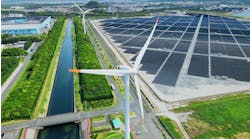Before “smart” became an adjective frequently attached to nonliving things, the Living Building Challenge (LBC) emerged as one of the most rigorous and respected sustainable certification programs. Created by the Seattle-based International Living Future Institute, the program requires projects to be regenerative, contribute positively to the environment, connect people to nature, place, and beauty, and comprise nontoxic materials that do not appear on the nonprofit organization’s Red List. Further, for one year of operation, stakeholders would have to prove their buildings generated their own energy and supplied and treated their own water.
In August 2021, the organization named environmental advocate, building scientist, and climate entrepreneur Lindsay Baker as CEO. Baker has long been active in the climate and building sectors, having previously worked at the U.S. Green Building Council, Google, Comfy (a smart building startup Baker also co-founded), and WeWork. In May, she spoke with SBT about the connection between Living Buildings, smart building technology, society, and the environment.
SBT: How do you define a smart building?
Baker: A smart building is a building that uses technology to achieve its goals. For me, the smartness of a building isn’t ever the goal. The goal is to be human centered in a way that stewards resources as effectively as possible. But buildings may have other goals: financial, risk-associated, or security-associated. Smart buildings are not always the most positively impactful buildings when it comes to social issues, or if their ability to track people can be used for malicious intent. But what I see in my world—and what I’m most passionate about—is their ability to effectively use resources and to make people healthy and comfortable.
It’s less about the question of the technology itself and more about to what end. I can’t tell you how many conference presentations I’ve seen where someone will ask, “How could we use this technology in buildings?” The technology could be anything from artificial intelligence to drones to blockchain to sensors. That’s the most backwards way of solving problems in the world.
How do Living Buildings and smart buildings relate?
Living Buildings and smart buildings show us what buildings are capable of.
Living Buildings and smart buildings show us what buildings are capable of. A Living Building has technologies that enable human flourishing, but it doesn’t have to be a smart building. A Living Building could be a beautifully built, off-the-grid Adobe house that retains heat.
But the reality is that the world is moving into cities, and we need buildings that are efficient in terms of their use of space. If buildings are going to sustain billions of people, they have to be intelligent. Getting the right temperature and amount of air circulation is hard in dense environments.
A living building is fundamentally about values. It’s about having a regenerative, positive impact on the world in the areas of climate health and equity, whereas a smart building isn’t necessarily looking to have a positive impact on the world.
The LBC has driven many changes in manufacturing and product transparency. But, as you mention, a smart building doesn’t necessarily have to comply with the Red List—though it would be nice.
Our role in the building industry is to give people aspirational goals and to help them articulate “What does good look like?” When it comes to smart building components and infrastructure, our Red List and the LBC are good frameworks.
How can smart building technologies help achieve Living Building certification?
There’s a lot that I wish technology was better at helping us to do. On the energy side, we’re getting it dialed in. If smart building technologies were more interoperable, then it would be easier to retrofit existing buildings. We could bring energy infrastructure costs down further to make it accessible for everyone to monitor their energy use or to shut down or schedule operations.
Ideally, from a health and climate perspective, more buildings would have operable windows, and technology would ensure that the windows are not open when the air conditioning or heating is on. If we could bring the cost down of such technologies, that would allow us to utilize the outdoor air, make ourselves comfortable, ventilate the space, and reduce energy consumption. The pandemic showed us the importance of that important that control.
Technology does some things a lot better than humans. Sometimes we need technology to remember to turn the lights off at the end of day or to close the windows. Data is another good example. We don’t do a great job of gathering information about our buildings so that we can analyze how things are going. And that’s a huge opportunity for smart buildings.
We don’t do a great job of gathering information about our buildings so that we can analyze and understand how things are going. And that’s a huge opportunity for smart buildings.
With your experience in early iterations of smart technologies and smart building portfolios, at companies like Comfy and WeWork, are the technologies’ capabilities and adoption rates where you would expect?
Around the world, many expensive, well-run, Class A buildings are still functioning with outdated technology—computers and operating systems from the ’80s and ’90s. This is because we function at an intersection of infrastructure that has actual physical limitations and an expectation that something should be digitally controlled.
Think about cars. Typically, newer cars are smarter and older cars are dumber. When a car gets too old, it goes to the dump. But when buildings get old, somebody still tries to come in and make that building smart. That intersection of old infrastructure and new technology makes things difficult. We are way behind on making buildings more intelligent, but taking billions of square feet of existing buildings and renovating them so they can be operated in a digital construct is challenging.
I’ve had many conversations with building operators to get them interested in new technologies. But there is a lack of incentive for them to try new things. Some of it deals with leasing structures or the fact that a building using more energy doesn’t affect their budget. Other concerns are that the technology will result in more headaches in their job and that automation will take away jobs.
In my early years at Comfy, a chief engineer of a big building essentially said, “I have a full-time person responding to hot and cold complaints, and that is a person with a wife and a family and a house. And if you put that person out of work, then I have to tell them that they don’t have a job anymore. And I have to tell their wife that they don’t have a job anymore. And I don’t want to do that.”
I also don’t want to put that person out of work, but I thought they could probably spend their day on something other than responding to hot and cold complaints. Big buildings have so much room for optimization and improvements, but if you’re used to doing that job, maybe that incentive isn’t big enough. That aspect of the smart buildings community is particularly important.
This is where some of the social impact work comes in. We need workforce training. We need to make building operations a sexy job, and we do that in part through making sure people understand that it is a technology-filled job, that if you enjoy working with data, computers, sensors, and other gadgets, you might enjoy this as a career—and have a real-world impact. I don’t think people think of building management as a tech career. These are jobs that, I hope, have pensions and opportunities to grow over time. And they’re needed everywhere around the country.
The building controls community has also slowed itself down massively by believing that it was possible for digital systems to not interoperate. I think we’re past that now, but we wasted a few decades on that type of behavior. In retrospect, I’m surprised that the building controls industry didn’t learn faster from the broader computer industry. Apple, Microsoft, and Google realized a long time ago that they weren’t going to be able to say, “No, you can’t run this Microsoft program on your Apple device.” You have to do that in order to grow the whole ecosystem and for everybody to make money.
Apple, Microsoft, and Google realized a long time ago that they weren’t going to be able to say, “No, you can’t run this Microsoft program on your Apple device.”
But in the building controls industry, there was—and still is—a lot of that. Some systems weren’t designed to interoperate and a lot of them are stuck in buildings now. And we have problems that I wish the controls manufacturers could own a little more and put up the upfront cost associated with getting buildings to interoperate rather than pushing it to the owners, who didn’t understand that they were buying something that was potentially not going to function years later.
That has had a big impact on the willingness of the real estate and building industries to try new things. A lot of people got burned in the early 2000s thinking that they were trying a cool new technology. I’m a fan of real estate companies that designate a specific innovation program in which to try things that are understood to have more risk. Anything we can do to make sure that we lower the risk of failure for our clients is important.
One reason why tech companies have been early adopters in the smart buildings world is because they have a different culture. If some lights stop working, then the engineers who work there understand why that might be. They live in an environment where you iterate and improve.
How has interest in high-performance buildings changed across different stakeholders over time?
Climate tech has started to grow in investment, which has had an impact on the building sector. It’s hard to say this because of the heart-breaking loss of more than a million people in America due to COVID-19, but people have come to understand the huge impact buildings have on our health.
As a result, we’ve seen a wave of commitment to ensuring that our buildings are providing adequate ventilation. About five years ago, I remember trying to make the argument that smart building technology could improve occupant satisfaction. People in the real estate world would say, “That sounds cool, but it doesn’t matter to us. We can’t quantify it. It doesn’t affect our bottom line.” And now that we have faced an actual existential threat to our species, people understand that having adequate air to breathe is something you figure out how to build into your bottom line.
For reasons associated with our economy and what we’ve been through as a society, more companies care about their environmental and social impacts. That is leading them to asking questions that we’ve wanted them to ask for a long time: What impact do you want to have on the world? What impact do you want to have on your employees? How are you going to measure that? How are you going to gather that data? And the more they ask those good questions, the more they find programs like Living Buildings, LEED, and WELL; and techniques like smart building technologies.
We’re seeing a wave of commitments along the lines of having bold carbon, health, and social impact statements and metrics. We know how to help a company hit those types of goals, and we’re ready to help people scale.
We’re also seeing more policy interest in setting expectations and regulations for buildings and in electrification. It’s hard to prove to your local city government that your building is using a specific amount of energy per square foot and to complete the documentation requirements necessary for these new regulations if you don’t have any technology in your building. This all will push us toward faster transformation and toward smart buildings.
This conversation has been condensed and edited for clarity.



